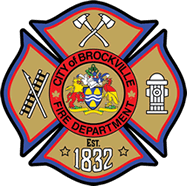Frequently Asked Questions
What are the guidelines for outdoor fireplaces in the City of Brockville?
How can I check to see if my personal information is correct for a 911 fire call?
Our databases reflect the information provided to us by the Municipal Property Assessment Corporation (MPAC). It is essential that your property information be current in order for our emergency services to respond effectively. If you would like to contact MPAC regarding your records, you can visit their website www.mpac.ca.
If you have any further questions regarding our emergency services, please email us at 911@brockville.com.
What type of smoke alarm should I purchase for my home?
There are smoke alarms available with different features and applications, so choosing the right alarm can be confusing. Some of the features to consider include:
- Power Source: Smoke alarms can be electrically powered, battery powered, or a combination of both. If you are installing an electrically powered alarm it is recommended that it have a battery back-up in case of power failures.
- Technology: most smoke alarms employ either ionization or photo-electric technology. Ionization alarms may respond slightly faster to flaming-type fires, while photo-electric alarms may be quicker at detecting slow, smoldering fires.
- Hush feature: Smoke alarms with a hush button are highly recommended as it permits the alarm to be temporarily silenced without disconnecting the power source.
Who is responsible to provide and maintain smoke alarms in rented residential units?
Tenant to notify landlord
A tenant of a rental suite shall notify the landlord as soon as the tenant becomes aware that
(a) a smoke alarm in the unit is disconnected,
(b) a smoke alarm in the unit is not operating, or
(c) the operation of a smoke alarm in the unit is impaired.
Disabling prohibited
No person shall disable a smoke alarm.
Penalty
Any person found guilty of failing to install a smoke alarm, failing to maintain a smoke alarm or disabling a smoke alarm may be subject to a fine of not more than $50,000 or imprisonment for a term of not more than one year, or both.
What should I do if I move into an apartment that is not equipped with a working smoke alarm?
Smoke alarms save lives – don’t live without them!
Notify the building owner/superintendent that there is not a functional smoke alarm in the apartment. Should a smoke alarm not be provided or repaired within a reasonable time (24 hours) contact your local Fire Department.
Where should I install my smoke alarms?
(a) if a sleeping area in a dwelling unit is served by a hallway, in the hallway,
(b) if a sleeping area in a dwelling unit is not served by a hallway, between the sleeping area and the remainder of the dwelling unit,
(c) if a sleeping room is not within a dwelling unit, in the sleeping room, and
(d) on each storey without a sleeping area in a dwelling unit.
Why does my smoke alarm go off a lot?
- Relocate the alarm. Sometimes moving the alarm just a few inches can make the difference.
- Install a smoke alarm with a pause button that will allow you to temporarily silence the alarm.
- Replace alarms located near kitchens with photo-electric types.
- The alarm may just need to be cleaned. With a soft brush on the vacuum, gently vacuum the smoke alarm to remove any dust or other foreign objects.
How often should smoke alarms be tested?
What kind of fire extinguisher should I have?
All household extinguishers are classified A, B, or C (or a combination of these) on the label to indicate which types of fires – ordinary combustibles, flammable liquids, or electrical – you can use them on. Many of the ones sold at home are classified A:B:C and fight all three types of fires.
Where should I store my extinguisher?
No matter how carefully they are selected, fire extinguishers won’t be of any use if they can’t be accessed in an emergency. Locate extinguishers where they are readily available for use while a fire is still small. However, don’t locate them where they could be a hazard to the person attempting to retrieve it.
Here are some general pointers to locate extinguishers in your home.
Install them;
- So that they are visible. (In the bracket or on the wall hook that was supplied with the extinguisher).
- Where they can be easily reached (not in the cabinet under the kitchen sink).
- In or near corridors leading to exits.
- Close to potential fire hazards, but not so close that they could be damaged or cut off by a fire.
What is the most common cause of residential fires?
Do I need a carbon monoxide alarm in my home?
- For detached or semi-detached and multi-unit residential buildings;
If a fuel-burning appliance or a fireplace is installed in a suite of residential occupancy, a carbon monoxide alarm shall be installed adjacent to each sleeping area in the suite.
- For multi-unit residential buildings;
If a fuel-burning appliance associated with building services is installed in a building, but not within a suite of residential occupancy, a carbon monoxide alarm shall be installed
(a) in the service room or area where the appliance is installed,
(b) adjacent to each sleeping area in each suite of residential occupancy that has a common wall or common floor/ceiling assembly with the service room or area where the appliance is installed, and
(c) adjacent to sleeping rooms that are not within a dwelling unit.

